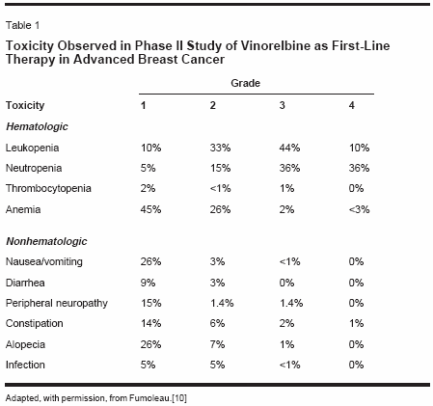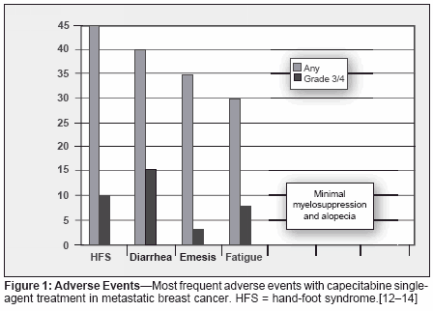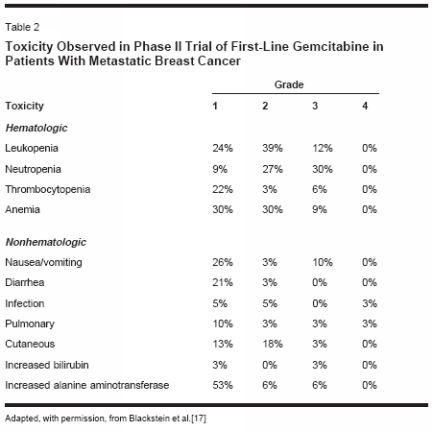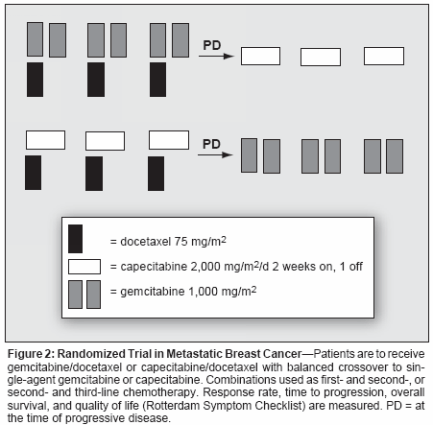Single-Agent or Combination Chemotherapy in Metastatic Breast Cancer
It is fair to say that combination chemotherapy is the standard of care inmetastatic breast cancer. In many ways, however, the burden of proof that it isthe standard of care remains with those who advocate combination therapy.Some of the push to consider combination therapy as the standard is provided by ameta-analysis of trials comparing single-agent and combination therapy in thissetting, which was reported by Fossati et al in 1998.[1] Although the vast majorityof individual trials included in the analysis did not show significant differences inhazard ratios for death, the meta-analysis showed a significant mortality advantagefor combination therapy. Yet the total population considered in this meta-analysis(990 patients in combination groups, 996 in single-agent groups) is not largecompared with some recent phase III trials in metastatic breast cancer, includingone reported by Sledge et al that showed that sequential doxorubicin and paclitaxelwas equivalent to the concurrent combination.[2] Further, no studies includingtaxanes are included in the meta-analysis, raising questions about the application ofits findings to contemporary oncology. In addition, the trials included did notexamine sequential single-agent treatment, an approach that clearly has merit andthat requires additional consideration and study.
It is fair to say that combination chemotherapy is the standard of care inmetastatic breast cancer. In many ways, however, the burden of proof that it isthe standard of care remains with those who advocate combination therapy.Some of the push to consider combination therapy as the standard is provided by ameta-analysis of trials comparing single-agent and combination therapy in thissetting, which was reported by Fossati et al in 1998.[1] Although the vast majorityof individual trials included in the analysis did not show significant differences inhazard ratios for death, the meta-analysis showed a significant mortality advantagefor combination therapy. Yet the total population considered in this meta-analysis(990 patients in combination groups, 996 in single-agent groups) is not largecompared with some recent phase III trials in metastatic breast cancer, includingone reported by Sledge et al that showed that sequential doxorubicin and paclitaxelwas equivalent to the concurrent combination.[2] Further, no studies includingtaxanes are included in the meta-analysis, raising questions about the application ofits findings to contemporary oncology. In addition, the trials included did notexamine sequential single-agent treatment, an approach that clearly has merit andthat requires additional consideration and study.In addition to the trial reported by Sledge and colleagues, other trials reportedsince publication of the meta-analysis have failed to show consistent superiority ofconcurrent combination therapy, including trials showing superiority of paclitaxelover cyclophosphamide (Cytoxan, Neosar)/methotrexate/fluorouracil/prednisone,[3]and docetaxel (Taxotere) over mitomycin (Mutamycin) plus vinblastine.[4] Sequentialfluorouracil, epirubicin (Ellence), cyclophosphamide (FEC) followed bymitomycin/vinblastine was as efficacious as epirubicin followed by mitomycin,[5]as was doxorubicin monotherapy compared with doxorubicin/vinorelbine,[6] andmitoxantrone (Novantrone) monotherapy as compared with FEC[7]; toxicitieswere generally more significant with combination regimens.Ongoing trials with newer concurrent combinations may well provide persuasiveevidence of the superiority of this approach. Still, it behooves us as physiciansto remember that survival data from a given clinical trial do not provide the wholestory of a patient's treatment during the course of her (or his) experience withmetastatic breast cancer. In discussing chemotherapeutic approaches in this setting,we are not yet talking about curative regimens, but rather regimens that can prolongsurvival or time to disease progression and that offer some measure of palliation.Part of the aim of such treatment is to preserve quality of life. In selecting suchtreatment, it is thus of importance to consider and balance benefit and risk in theform of efficacy and toxicity. Single-agent chemotherapy may pose some advan

tages in regard to reducing negative effects on quality of life by minimizingtoxicity. The other papers in this supplement focus on promising combinationchemotherapy regimens in metastatic breast cancer. In the absence of definitiveevidence of the superiority of this approach-eg, vs sequential single-agent treatment-it is also important to consider the potential merits of single-agent treatment.The most widely used agents in patients with metastatic breast cancer whohave already received anthracycline/taxane treatment are gemcitabine (Gemzar),capecitabine (Xeloda), and vinorelbine (Navelbine). There are no data from phaseIII trials that directly compare these agents to one another. Phase II trials ofvinorelbine in refractory disease indicate objective response rates of 16% to34%.[8,9]In a recent phase III trial in 301 patients with taxane-refractory metastaticbreast cancer, liposomal doxorubicin was compared with vinorelbine or mitomycin/vinblastine, based on patient/physician choice; 85% of patients randomized tothe comparator group chose vinorelbine treatment rather than the combination.Among 209 evaluable patients, responses included complete response in 3% of theliposomal doxorubicin group vs 3% of the entire comparator group, partial responsein 10% vs 12%, and stable disease in 44% vs 37%.Representative toxicities of vinorelbine observed in a phase II study of firstlineuse are shown in Table 1.[10] One particular concern regarding administrationof vinorelbine after a taxane is neurologic toxicity from sequential use of antimicrotubularagents. For example, Fazeny et al reported that of 14 advanced breastcancer patients previously treated with a taxane, 4 had vinorelbine treatmentdiscontinued due to peripheral neuropathy, and 10 had grade 2 constipation.[11]In previously reported phase II studies in taxane-pretreated patients, capecita-

bine has been associated with response rates of 15% to 25%, response durations of7.9 to 8.3 months, times to progression of 3.0 to 3.2 months, and overall survival of12.2 to 12.6 months.[12-14] The most frequent adverse events in this setting arehand-foot syndrome, diarrhea, emesis, and fatigue (Figure 1).[13] In a large phaseII trial in 136 patients with taxane- and anthracycline-refractory disease, capecitabinetreatment produced a 15% objective response rate, with rates of any/grade 3 or4 toxicities being 55%/13% for hand-foot syndrome, 60%/7% for nausea/vomiting,and 28%/8% for diarrhea.[14] Similar to vinorelbine and gemcitabine, capecitabinetreatment is associated with little to no alopecia.Gemcitabine has been assessed as a single-agent in 11 phase II trials involvingmore than 300 metastatic breast cancer patients, most of whom had previouslyreceived anthracycline or taxane treatment. Objective response rates in these trialsranged from 13% to 42%, based primarily on the extent of previous chemotherapy,and overall median survivals ranged from 11.5 to 17.8 months.[9] In three trials inpatients with both anthracycline- and taxane-refractory disease, objective responserates ranged from 18% to 25%.[9,15,16] Grade 3 or 4 toxicities generally consist ofneutropenia, with some thrombocytopenia and nausea/vomiting; grade 4 toxicitiesare infrequent. Table 2 shows toxicities observed in a recent phase II trial of firstlinegemcitabine therapy in patients with metastatic breast cancer.[17]Support for the use of combination chemotherapy in metastatic disease wasgenerated by results of a phase III trial reported in 2002, which demonstratedsuperiority of docetaxel/capecitabine over docetaxel alone in anthracycline-pretreatedpatients.[18] Furthermore, interim results of a phase III trial comparinggemcitabine/paclitaxel with paclitaxel alone in anthracycline pretreated diseaseshowed superiority of the gemcitabine/paclitaxel combination.[19] While thesestudies may encourage the use of combinations rather than single-agent chemotherapiesas a first step, they do not inform us regarding the validity and utility ofsequential single-agent treatment approaches. Therefore, whether combinationtreatment is optimal in this setting is still uncertain, and the question of whichtreatment(s) to use beyond this first step remains to be answered. Another ongoingphase III trial in patients with metastatic disease will provide some answers to thelatter issue. In this trial, patients are being randomly assigned to receive docetaxel/gemcitabine followed by capecitabine or docetaxel/capecitabine followed by gem-

citabine (Figure 2). Results of this trial promise to be helpful in planning treatmentbeyond the first chapter in the course of metastatic disease.The other contributions to this supplement review the rationale for use of andthe outcomes observed with the promising combination of gemcitabine and paclitaxel.Joyce O'Shaughnessy reviews compelling data supporting use of the gemcitabine/paclitaxel combination and describes interim analysis findings of amultinational phase III trial comparing gemcitabine/paclitaxel with paclitaxel alonein patients with metastatic breast cancer. Carlos Delfino and colleagues explorephase II trial results for gemcitabine/paclitaxel as first-line treatment of advancedbreast cancer. Andr Murad updates findings of a phase II trial of gemcitabine/paclitaxel as salvage therapy for metastatic disease. George Sledge discusses therationale for the triple combination of gemcitabine/paclitaxel plus trastuzumab (Herceptin)and reviews findings of a phase II trial of the combination in patients withHER2-positive disease. Christoph Zielinski discusses the rationale for gemcitabine/paclitaxel/anthracycline combinations and reviews available information from trialsexamining gemcitabine/paclitaxel in combination with doxorubicin or epirubicin.

The data reviewed herein demonstrate that gemcitabine combinations arehighly active and well tolerated in the setting of metastatic disease, indicating animportant role for this agent in breast cancer. Optimizing use of such promisingagents and combinations throughout the many chapters of a patient's experiencewith breast cancer is a central challenge in patient care. Recognition of the heterogeneityin the biology and behavior of metastatic breast cancer will most certainlyimply heterogeneity in treatment strategies; this is indeed where the art and scienceof medical oncology merge.
Disclosures:
The author(s) have no significant financial interest or other relationship with the manufacturers of any products or providers of any service mentioned in this article.
References:
1.
Fossati R, Confalonieri C, Torri V, et al: Cytotoxic and hormonal treatment for metastaticbreast cancer: A systematic review of published randomized trials involving 31,510 women. J ClinOncol 16:3439-3460, 1998.
2.
Sledge GW, Neuberg D, Bernardo P, et al. Phase III trial of doxorubicin, paclitaxel, and thecombination of doxorubicin/paclitaxel as front-line chemotherapy for metastatic breast cancer: AnIntergroup trial. J Clin Oncol 21:588-592, 2003.
3.
Bishop JF, Dewar J, Toner GC, et al: Initial paclitaxel improves outcome compared withCMFP combination chemotherapy as front-line therapy in untreated metastatic breast cancer. JClin Oncol 17:2355-2364, 1999.
4.
Nabholtz JM, Senn HJ, Bezwoda WR, et al: Prospective randomized trial of docetaxelversus mitomycin plus vinblastine in patients with metastatic breast cancer progressing despiteprevious anthracycline-containing chemotherapy: 304 Study Group. J Clin Oncol 17:1413-1424,1999.
5.
Joensuu H, Holli K, Heikkinen M, et al: Combination chemotherapy versus single-agenttherapy as first- and second-line treatment in metastatic breast cancer: A prospective randomizedtrial. J Clin Oncol 16:3720-3730, 1998.
6.
Norris B, Pritchard KI, James K, et al: Phase III comparative study of vinorelbine combined with doxorubicin versus doxorubicin alone in disseminated metastatic/recurrent breastcancer: National Cancer Institute of Canada Clinical Trials Group Study MA8. J Clin Oncol18:2385-2394, 2000.
7.
Heidemann E, Stoeger H, Souchon R, et al: Is first-line single-agent mitoxantrone in thetreatment of high-risk metastatic breast cancer patients as effective as combination chemotherapy?No difference in survival but higher quality of life were found in a multicenter randomized trial.Ann Oncol 13:1717-1729, 2002.
8.
Domenech GH, Vogel CL: A review of vinorelbine in the treatment of breast cancer. ClinBreast Cancer 2:113-128, 2001.
9.
Seidman AD: Monotherapy options in the management of metastatic breast cancer. SeminOncol 30(suppl 3):6-10, 2003.
10.
Fumoleau P, Delgado FM, Delozier T, et al: Phase II trial of weekly intravenousvinorelbine in first-line advanced breast cancer chemotherapy. J Clin Oncol 11:1245-1252, 1993.
11.
Fazeny B, Zifco U, Meryn S, et al: Vinorelbine-induced neurotoxicity in patients withadvanced breast cancer pretreated with paclitaxel-A phase II study. Cancer Chemother Pharmacol39:150-156, 1996.
12.
Blum JL, Jones SE, Buzdar AU, et al: Multicenter phase II study of capecitabine inpaclitaxel-refractory metastatic breast cancer. J Clin Oncol 17:485-493, 1999.
13.
Blum J, Dieras V, LoRusso PM, et al: Multicenter, phase II study of capecitabine intaxane-pretreated metastatic breast carcinoma patients. Cancer 92:1759-1768, 2001.
14.
Reichardt P, von Minckwitz G, Thuss-Patience PC, et al: Multicenter phase II study of oralcapecitabine (Xeloda) in patients with metastatic breast cancer relapsing after treatment with ataxane-containing therapy. Ann Oncol 14:1227-1233, 2003.
15.
Valerio MR, Cicero G, Armata MG, et al: Gemcitabine (G) in pretreated breast cancer(BC) (abstract 1953). Proc Am Soc Clin Oncol 20:51b, 2001.
16.
Rha SY, Jueng H, Kim Y, et al: Efficacy of gemcitabine as a salvage treatment in breastcancer patients refractory to anthracycline and paclitaxel based regimens (abstract 2038). Proc AmSoc Clin Oncol 21:57b, 2002.
17.
Blackstein M, Vogel CL, Ambinder R, et al: Gemcitabine as first-line therapy in patientswith metastatic breast cancer: A phase II trial. Oncology 62:2-8, 2002.
18.
O'Shaughnessy J, Miles D, Vukelja S, et al: Superior survival with capecitabine plusdocetaxel combination therapy in anthracycline-pretreated patients with advanced breast cancer:Phase III trial results. J Clin Oncol 20:2812-2823, 2002.
19.
O'Shaughnessy J, Nag S, Calderillo-Ruiz G, et al: Gemcitabine plus paclitaxel (GT)versus paclitaxel (T) as first-line treatment for anthracycline pre-treated metastatic breast cancer(MBC): Interim results of a global phase III study (abstract 25). Proc Am Soc Clin Oncol 22:7, 2003.